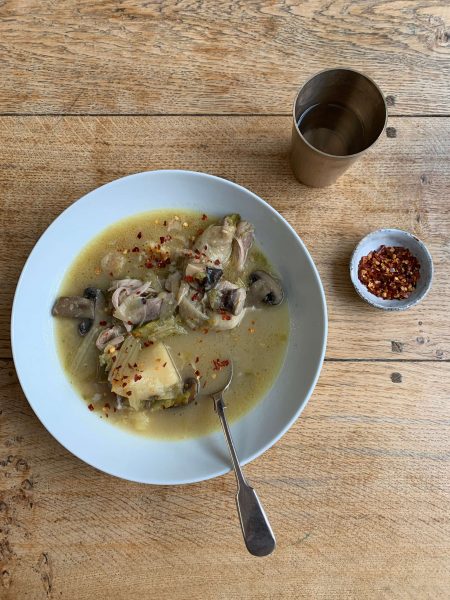I am a huge advocate of meals cooked in one pot. I love to throw everything in, add my twist in terms of seasoning, herbs and the like, and watch the alchemy of the flavours coming together to create a hearty, wholesome and utterly delicious meal. From an Ayurvedic nutrition point of view, this is also the easiest way to ensure all six tastes are present. I have recently been doing this with chicken and vegetables left over from a roast meal. I buy a larger chicken than I will need, and make more vegetables too (although I confess I tend to make too many vegetables at the best of times). The beauty of this kind of cooking is that you get two, if not three meals out of the original ingredients, and you also don’t need to spend time planning and buying for the next day’s meal.

I make two versions of this meal, to mix things up a bit. The first one, as the photo shows, uses the chicken and vegetables, and the second one has the addition of small pasta- either ditalini, or the slightly chunkier mezzi rigatoni. I prefer using the latter in this dish, as ditalini can get somewhat lost amongst the big, bold pieces of chicken and vegetables. The parmesan is a wonderful addition too, making it feel Italian, regardless of whether you add the pasta, and reminiscent of a dish that would be served in a local, family-run restaurant somewhere gorgeous….let’s say Florence!
Ingredients to serve 4-6:
A chicken carcass from a cooked roast chicken meal, with plenty of chicken still on it
The leftover vegetables from your meal
Two teaspoons dijon mustard
Vegetable stock
Leftover gravy
Jaggery or date syrup
Salt and pepper
Chilli flakes
Fresh rosemary and/or fresh thyme
A bayleaf
Three handfuls of mezzi rigatoni pasta (optional- I often add pasta the following day if there is any casserole left)
Half a medium orange/lemon
A large onion
A two inch square piece of parmesan cheese
Ghee or olive oil
Method:
Place the chicken carcass in a large casserole pot with a lid. If you stuffed the chicken with herbs such as sprigs of rosemary or thyme, and perhaps half an orange/lemon, and some onion, as I tend to do, they will go in with the carcass, but if not, you can add a couple of sprigs each of rosemary and thyme, and perhaps a bayleaf now. Add your leftover vegetables- this will include roast potatoes, all the other vegetables you may have roasted or sauteed, such as any greens. If you didn’t use onions in your roast, chop a large one into chunky pieces, and add them to the pot too.
Now pour in enough vegetable stock to mostly cover the chicken carcass, and throw in any leftover gravy you may have too. Add the dijon mustard, around a teaspoon of jaggery or date syrup, a teaspoon of chilli flakes, and season well. Cook on a low/medium heat for 45 minutes, before placing the orange/lemon half, if you didn’t use one in your original roast, and the piece of parmesan, in the centre of the pan. Continue to cook for another half hour or so, adding your optional pasta fifteen minutes before the end of the cooking time. Stir everything well a couple of times to make sure the pasta is distributed. At the end of the cooking time, everything will be soft, the pasta will be cooked ‘al dente’, and the chicken will have mostly come away from the carcass.
Check and adjust seasoning, and turn off the heat. Let it sit for 10 minutes. Wearing a rubber glove, carefully lift the carcass up, cut any still- attached chicken with a blunt knife so it falls back in the pan, and place the bare carcass in a bag or in some newspaper to put in the bin once cool. Remove the orange too, after giving it a good squeeze into the pot. Stir in a couple of teaspoons of ghee, or pour a good glug of olive oil on top. Let it sit for a few minutes again.
To serve, ladle into warmed bowls, discarding any smaller bones that have remained. Have some extra chilli flakes on the table for those who might want more heat.
